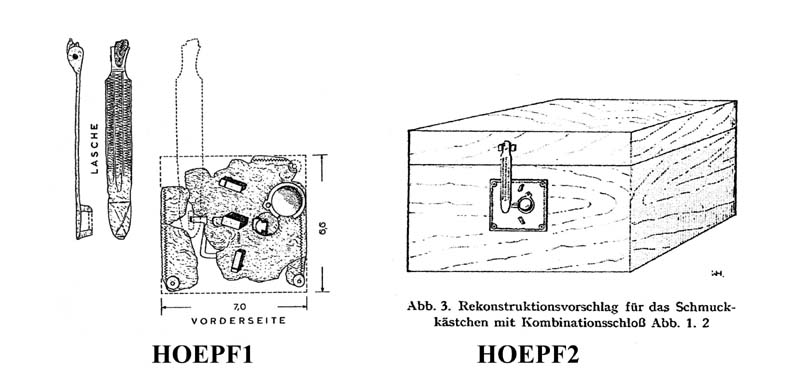

![]()
Most of the locks, keys and other security hardware that are discovered, offered for sale and collected at this time are for chests and boxes. This includes keys, lock plates, bolts, hasps, handles, hinges, fastenings and decorations. Judging from the vast numbers of ring keys and lock bolts that have been found, the use of chest locks was wide spread, perhaps even universal among those prosperous enough to have something to protect.
There are several types of containers that would have been locked. First and most important would be the arca or household safe, kept by the master of the house in the tablinium. This would be a heavy chest, sometimes chained to the floor, which would contain money and other valuables such as glassware, jewelry and expensive oils.
A capsa was a cylindrical wooden container for books: that is, numbers of scrolls stacked upright. It might also contain clothing or other items, but was mostly used for storing and transporting books for school boys. When the capsa contained books of importance, it was sealed or kept under lock and key. If used exclusively for books, letters and writing, it would be called a scrinium.
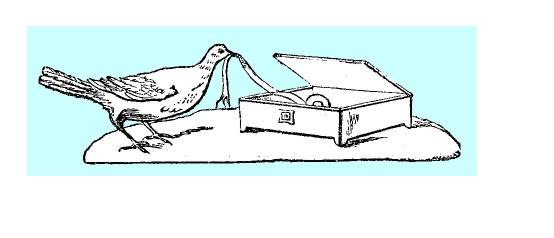 The illustration at left is a detail from a Roman fresco, showing a
bird stealing a ribbon from a pyxis, or jewelry casket (Smith's Dictionary).
Such a casket might contain jewelry, toilet articles, keys, coins,
anything small and valuable.
The illustration at left is a detail from a Roman fresco, showing a
bird stealing a ribbon from a pyxis, or jewelry casket (Smith's Dictionary).
Such a casket might contain jewelry, toilet articles, keys, coins,
anything small and valuable.
The following quote was taken from classicsunveiled as a simple but useful commentary on chests: "Chests were found in every house. They were usually made of wood and often bound with iron. Small chests, used as jewel cases, were sometimes made of silver or gold. Cabinets were made of the same materials as chests and were often beautifully decorated. They were frequently divided into compartments, but they had no sliding drawers and their wooden doors were without hinges or locks. The cabinets in the library held books, while those in the alae (side room) held wax masks of ancestors."
However, Johnston (Private Life of the Romans) tells us that "The cabinets, armaria, were designed for similar purposes (to the arca) and were always supplied with hinges and locks".
The image at right is from Jacobi, showing a small chest. However, I don't know what the evidence for it is, since I see no evidence of hasps, hinges or handles.
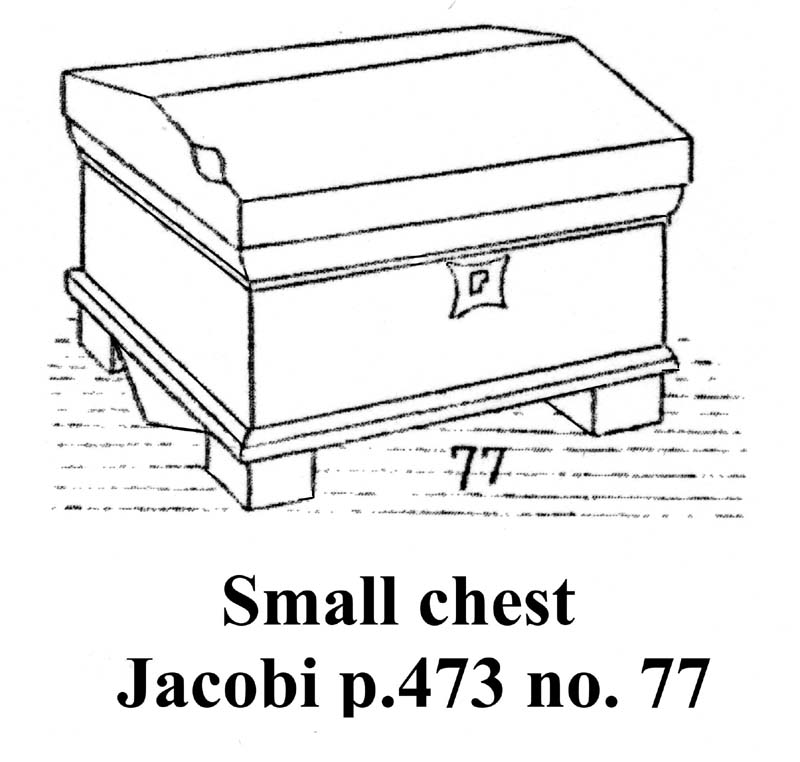
Surviving chests or remnants are extremely rare. A bronze offering arca with key from Gaul, dating to about A.D. 130-180, is in the Getty Museum, and can be seen online (see ref).
Augusta Raurica. For any collector, or for that matter any archaeologist who is interested in Roman chest hardware, the monograph by Riha on the discoveries at Augusta Raurica is a must-have. A large number of fittings, including locks, from chests and boxes were found at this site. In addition, there are many references to previous finds, and I know of no better source of reconstructions of Roman chests and boxes. This work is currently still in print.
However, reconstructions of chest lock mechanisms are unsatisfying. They invariably show bolts fastened by metal brackets (see Bruner, for example, or Connolly). To the best of my knowledge, such brackets have not been recovered, with the possible exception of a lock plate in the British Museum, as shown by Biasiotti. Also, metallic keepers for lock bolts have not been found, although I have seen telltale remnants of iron fittings on the tips of some bolts in this collection. I believe that the heads of bolts were usually seated in wood when locked.
Roman keys & caskets in Poland. Roman customs and artifacts spread far beyond the empire proper. It's worth mentioning the finds made in graves in Kowalenko in Poland, as part of a salvage archaeology project. The reference (muzarp) shows sets of casket fittings from the mid-1st century to the beginning of the 3rd.
Chest Lock Plates and Groups ![]()
Most lock plates were rectangular and made from bronze sheet. They were often decorated with a favorite design: concentric circles with a dot in the center. They were fastened to the chest with either iron or bronze nails or pins and usually the head was covered by a knob, sometimes figural.
Some are known with areas of gilding or silver plating. Thin washes of silver were probably applied from a silver amalgam. Plates could be perfectly flat, but often were folded over at the sides and must therefore have been inset slightly into the wood chest front, or more likely, protruding from it. The backs of plates were in contact with wood and a few still retain traces and impressions of the wood. The support frames must have been iron or wood, since none have survived. All bronze components except for plates and some decorations were lost wax castings. At this point, I don't know exactly how thin sheet bronze was fabricated. I have seen sheet as thin as 0.010", but can only suppose that it was made by heating and beating thicker cast sheet.
Plate group 4799 a-i This is an extraordinary set of chest lock hardware, alleged to be late Roman or early Byzantine, from the Holy Land, circa 4th-6th century CE. It's a nice example of a double hasp chest lock, consisting of a lock plate, two original hasps and the original bolt. Enough remains to attempt a reconstruction on paper although there were some problems. Parts of the lock plate are missing. The support for the bolt and pin assembly is missing, although there are iron stains and a missing area from the top of the bolt to show where it was. Some decorations are gone, and others are very faint. Everything is blurred by corrosion. 4799j is a back view of the group, showing the double bolt and the hasps in the assembled position, Tilted to show the bolt-hasp engagement more clearly.
Plate 4799. The lock plate is a mess. It was made from thin bronze sheet, and was fastened to the chest by eight bronze nails . Each nail passed through a bronze roundel (an elegant washer), now missing. Their presence is shown by a slight darkening of the plate around the nail holes. Their diameter was about 25 mm or close to 1 inch . This is the same as the markings on the hasps, and it's fair to assume that they had the same bulls eye or target markings . This was a favorite Roman decoration for lock and key hardware. In fact, there are also large diameter circles scribed into the plate, which are now very faint. They consist of three concentric bands, and there may have been more, but the center is lost.
Bolt 4799 The bolt is double, extended and recurved to lock both hasps. Dimensions of all the pieces show that the top surface of the bolt must be as shown. It would slide to the left to lock. There is considerable rust left in the top halves of the circular pattern of four holes at left. This must be from iron lock pins, since the residue does not go all the way down through the bolt. The two rectangular holes have no rust, probably indicating that these pins were never installed or had been removed for an easier fit. Similar double bolts will be encountered later.
Chest lock plates and groups
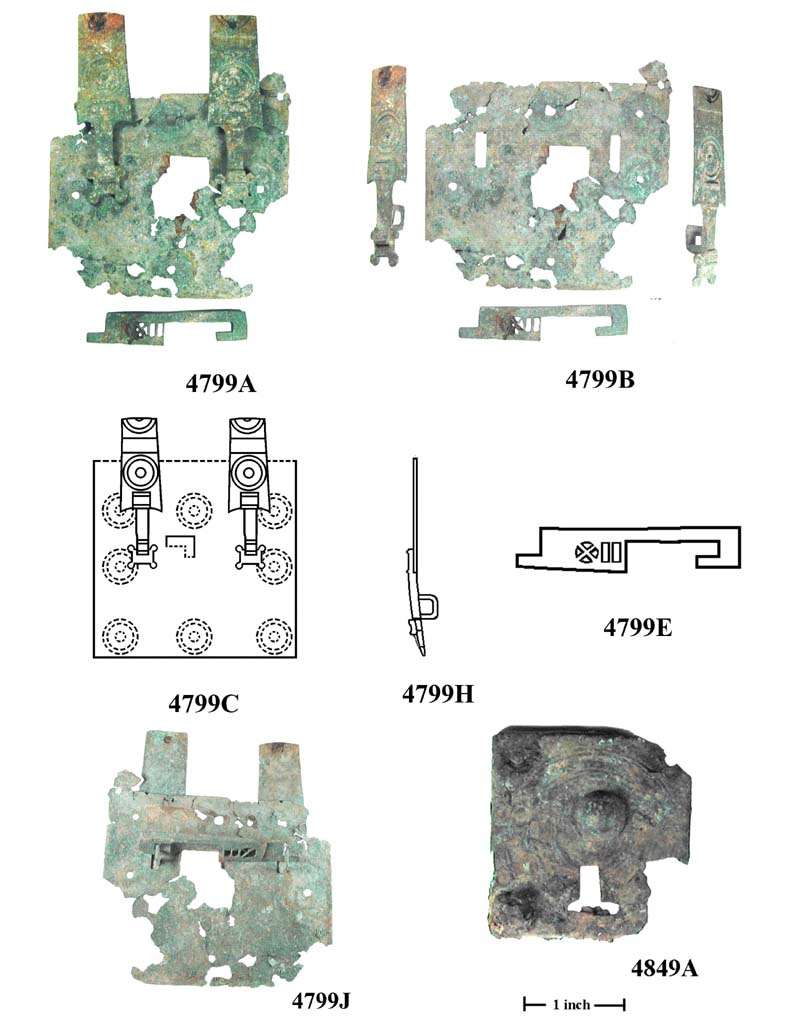
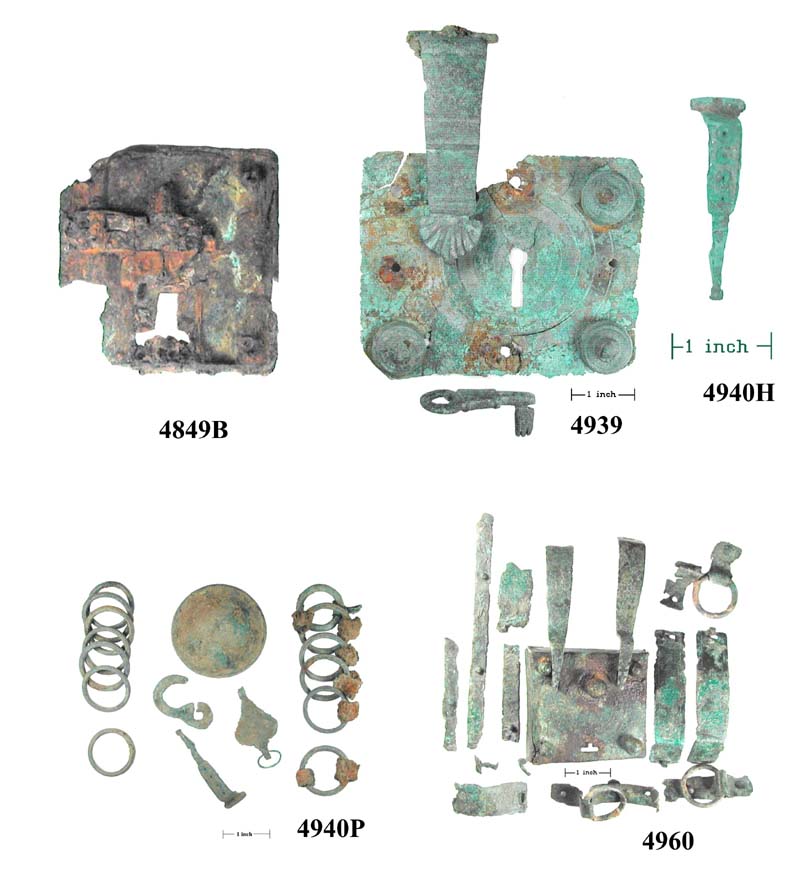
Hasps 4799 The hasps are sophisticated castings, much more elaborate than necessary. There was an iron pin at the top of each hasp, and the holes are still filled with rust. However, the rest of the connections are missing.
Plate group 4799 reconstruction. Presented here is a reconstructed front view of the lock, plus the bolt. Dotted lines are uncertain edges. The key is not available, although it would probably be a fairly ordinary ring key. Altogether, this must have been a most impressive lock when new. Double-hasp locks are less common than single-hasp and as we will see, have some interesting varieties. Shown here is a double hasp lock from Biasiotti,
a04w "Keys, Locks, and Padlocks from Pompeii" shows some of the same features: the slots for double hasps, roundels for the nails and the large diameter scribed circles.
Plate group 4849 a,b The fastenings were four iron pins, with iron caps. The off-center knob was movable and certainly part of the mechanism, but it's not clear to me how it worked. The reverse side shows what is obviously an iron bolt between bronze guides, and some means for moving it by the key. There is not enough remaining to be sure how it worked. The back side also shows many fragments of the wood in which the plate was mounted.
Plate group 4939. Unique lock plate, with ornate hasp and key found together. Decorated with silver plated concentric bands. Iron corner pins with figural lion bronze knobs and four holes for additional pins. Unusual bitted key with traces of original gilding. The hasp has a fragment of the original bronze box fitting stuck to it. It has a wide bronze pin at the top, retaining the remains of an iron connector in its center.
Plate group 4940 This is a group featuring a large number of decorative rings, most without connectors, and and some with both single and double iron connectors. The hasp is nice. and the leaf is much like one we'll see later, attached to a key. The roundel is a thick, sturdy cup shaped piece, function unknown. Also, there's a curious hook shaped object whose use is also not obvious.


Plate group 4960. Hinges, hasps, pinning nails and caps, several of the decorative rings and even some of the bronze chest reinforcing strips have survived. The case itself is of folded sheet bronze, about 0.037" thick. I believe that the larger off-center knob did the actual work of moving the bolt, probably by rotation, and that the key only released it to move. We can see the scribed rings on the front continuing on the sides, showing that the scribing was done before the bronze sheet was folded. The plate was not nailed, but pinned through the wood block. The flat pins have little holes near the end, presumably for their own pins. They only extend about 0.25" beyond the base of the lock plate, (4960R2), but there is evidence from interior and exterior markings and from the offset in the hasps that the plate was actually inset about 0.3" into the chest panel.
On the inside, (4960R), we can see the outline of an iron fitting around the keyhole, now mostly gone. The bit of it that remains as rust (4960R3) is partly blocking the keyhole. A considerable amount of wood remains, although not enough to tell us anything about the mechanism. The size of the hasp loops and the amount of wood remaining show that the remaining bolt material must still be present under the wood, but it is not visible.
Plate 4969 This unusual plate has 4 corner nail holes and 5 knobs, but no keyhole. The reverse side (4969R) indicates that one of the 4 edge knobs was rotatable and its bronze shaft once connected to a latching mechanism, now missing. Decorated with scribed patterns of concentric circles and straight border lines.
Plate 4983 Single hasp plate with the usual concentric ring decoration. 0.025" bronze sheet, folded over 0.17". Keyhole originally L-shape, partial loss.
Plate 4987 In addition to double bolt hasps and double hasp bolts, there is this unusual plate, which I assume is for a double bolt hasp. Could even be for 2 different keys, but there's no way to tell. It's worth noting that the slots align perfectly with hasp 4977.
Plate 5008 Chest lock plates are usually rectangular, but not quite always, as this example shows. The fastener holes were punched through from the back side, which is somewhat unusual. The plate was not cast but cut and folded from sheet bronze. The wide concentric bands are in relief, but there is no sign of them on the back, indicating that they were cut.
Plate group 5016. I can't be positive that all the pieces of this group were found together, but I'll present them that way anyway. The parts are interesting enough. The round fixture was alleged to be a handle but is probably a decoration, a large ring fastened to the thin chest plate with a typical cotter pin. The handle is in good shape, and attached similarly. This is a typical handle, if there is such a thing, ornamented at the recurved ends. The section of bronze that it is attached to is so thin (0.020" at this time) that there must have been a wood lining to back it up and the box itself must have been small and light. The bolt is both complex and unusual, and will be discussed in the section on bolts.
Plate 5030A This double hasp plate is a fairly typical example, with the usual concentric ring decoration, accented by silver plating. Itís notable mostly for its shutter treeatment. The heavy bronze lever at lower right operated a keyhole cover. Figure 5030B shows the remaining parts on the back side. The shutter itself was of iron and has been broken off. However, the position of the bronze pivot and the width of the part that was pivoted leave no doubt that it was used to cover the keyhole.
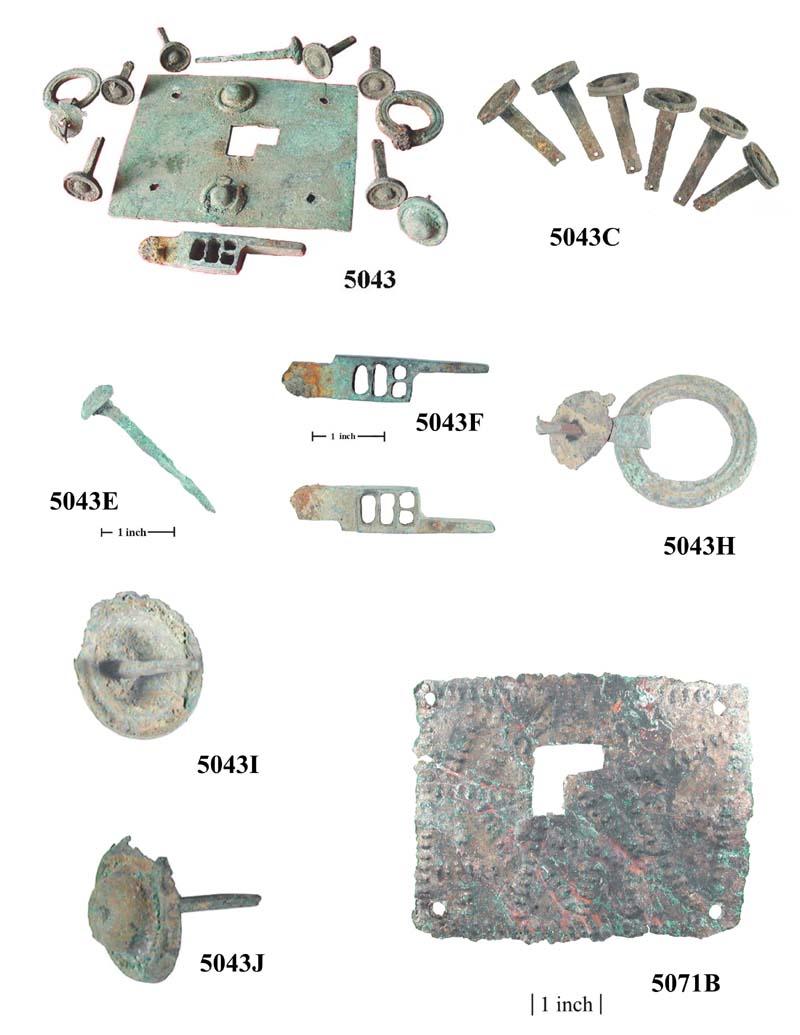
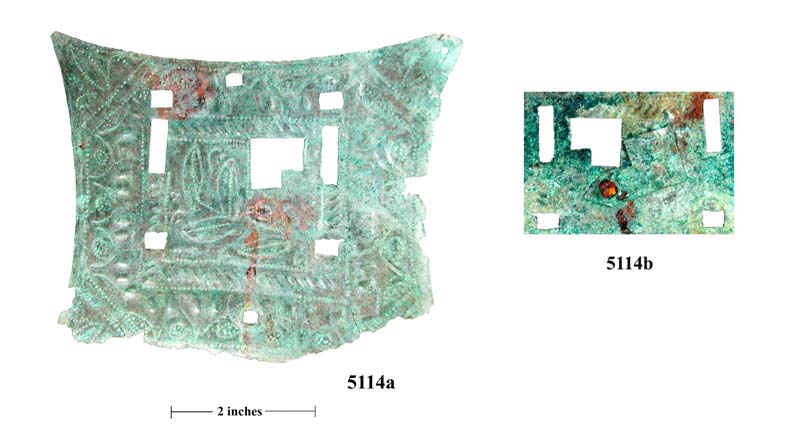
Fasteners
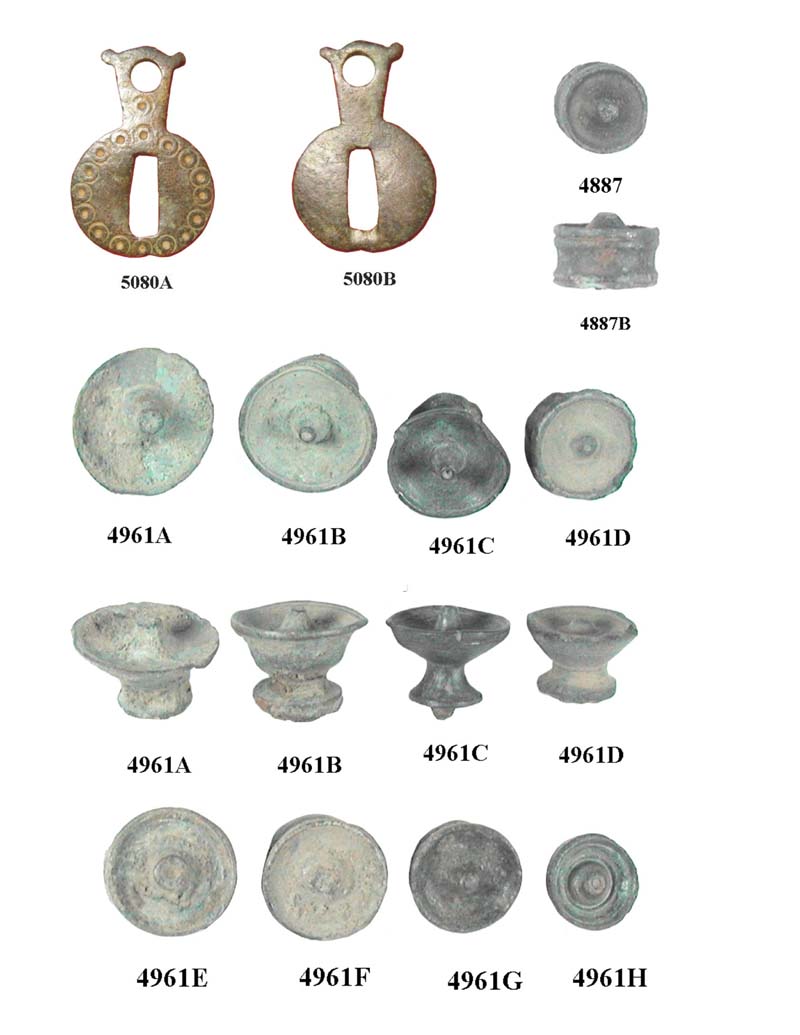

Plate Group 5043 There several features here for which I don't have other examples:
1. The decorative pins with rectangular shafts and pin holes, showing the depth of the wood container. Which is pretty thick, by the way, indicating that it was a sturdy chest rather than a small box.
2. The arrangement with two decorative dummy fastening knobs on the plate, peened over at the back, but with one of the actual mounting pins intact.
3. The 2" nail with the big cap
4. The heavy bolt with clear evidence that it was seated in an iron fitting.
Plate 5071 This one is thin enough (0.010") that the decoration is repousse. There are seemingly random strings of punched lines.
Plate 5114 Top-of-the-line, I suppose, with double hasp and elaborate geometric and floral designs repousse. The back view 5114b shows (faint outline) a shutter, pivoting on an iron shaft and operated from a front knob. The purpose of the shutter must simply have been to act as a dust cover and status symbol, no security added.
Escutcheon 5082 In addition to their role as mountings for mechanisms, lock plates can be thought of as escutcheons or keyhole covers. However, not all of them are large and elaborate. This is an example of an escutcheon for a rotary key, similar enough to its modern counterparts to be instantly recognizable. The dot-circle decoration is traditional, but I don't see how it was fastened to the wood chest.
Escutcheon Curle78-14 For comparison I've included this image of an iron escutcheon from Curle, plate 78, figure 14, found at the fort of Newstead. Some keys and lock parts are also illustrated in this reference.
Knobs 4887,4961 These small metal pieces are often found in association with chest fittings. They are sometimes designated as "lock pins", but I consider them to be plate fasteners, not tumbler/bolt pins. A number have been found at Vindolanda and at Augusta Raurica. Riha has a lengthy discussion of the various types, which may also have had various uses, both functional and decorative. Most are thought to have been used for fastening lock plates to wood chests and boxes. The examples shown here are bronze knobs, cast around iron center pins. They are similar to types found at Augusta Raurica.
Nails, pins, brads, tacks, caps 5080 Many fasteners were not nearly so prominent as knobs. There were a wide variety of rounded and decorative types such as this group.
Bolts for Chest, Cabinet and Box Locks. ![]()
The market for bronze bolts appears to be saturated, and they can be purchased for a few dollars. At first glance, they are all much alike, with minor differences in the numbers, shapes and placement of pin holes. However, they are much more than pretty decorations for the collector of Roman security hardware. They have something to say about the construction of locks, whose remains are now fragmentary.
Many of the exact details of construction are still unsettled. Based on the residues on and in bolts, I believe that pins were mostly round and made out of iron wire. The shapes of the holes in the bolt are not of much consequence. A round pin would nearly always serve and was very much easier to make than tear drop or other exotic shapes. All holes in the bolt had to have corresponding pins on the key, but not all of them had to have bolt pins. Bolts such as 4799 are found to have residue in some holes and nothing in others.
Since portions of locks are known to have been made of iron, there must have been problems with rusting and malfunctioning. It's likely that they were lubricated with olive oil rather than thicker animal fat, and perhaps even had to be disassembled and cleaned occasionally.
The different types of bolts that I've observed can be summarized as follows:
Type 1 Single bolts
1a Full head
1b Narrow head
1c Side projection
1d Pinning holes in head
1e Center notch
1f Slot in head
Type 2 Double bolts
2a Narrow head
2b Split head
2c Split head with center tab
2d Double recurve
Type 3 Triple bolts
Single bolts
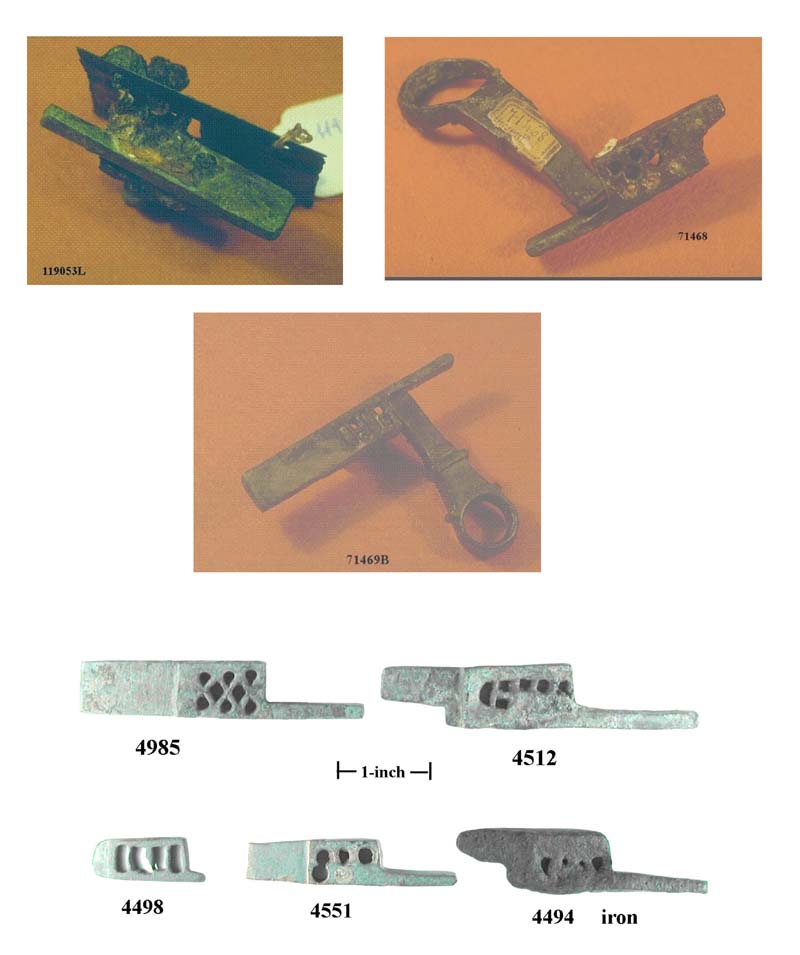
I'm showing first images of a lock found at Pompeii, which has a bolt still in place (Biasiotti 119053L, 71468, 71469b). Note that not all the holes have pins in them! Thanks to such images, we know that the normal operating position of the bolt is with the head to the left and the tail to the right and opposite the lock plate. Bolts are now usually displayed with the bottom up, since that has nearly all the interesting details. The tail appears to have not only the purpose of stabilizing and guiding the bolt in a slot, but also serves as a stop for the end of the key on insertion.
There is a curious feature that I haven't seen mentioned elsewhere. On a few bolts there is a high z-shaped ridge around the pin hole section. I've found it only on single bolt 4501 and double bolts 5015 and 5041. The only apparent purpose is to shield the pin holes, making it necessary for a key to have much longer pins than usual. The additional depth gained in this way is in the range 0.25-0.29" respectively for the three bolts. In this respect, a ridge would seem to act as a ward, prohibiting some types of keys and picks.
Type 1, single bolts
Types 1a and 1b, full and narrow head, respectively
I've assembled a group of 71 single bolts for this study. In this group, 51 are thinned or stepped down on the bottom side, typically starting about 0.75" from the left end. We can reasonably identify these steps as stops, intended to limit the entrance of the bolt into the chest door. No bolt has such a step on top.
Because of the lack of surviving support structures, I presume that these were always/usually/mostly made of wood. Similarly, it appears to me that the bolt was normally seated into wood, with one possible exception to be discussed below for a double bolt. I am not aware of any metal strikes that have been preserved.
53 bolts have notches in the head end, typically reducing the width by one third. Almost all notches are on the side away from the lock plate (I've seen one exception) and always end before the step up. The notch is probably the principal stop. I suggest that the reduced bolt width at the end also allows a stock bolt to be used with a thinner chest door that doesn' t have room for a full width bolt. Narrow bolts are 20% of the total, and there is even one, 4514, shown here, without ridge or notch. This interesting example also shows the slight taper usually found, presumably to allow the head to find the keep or receiver more easily. The two smaller, smooth, round holes probably have nothing to do with the original pin diameter, but result from cleaning since the bolt was dug.
Single bolts, continued
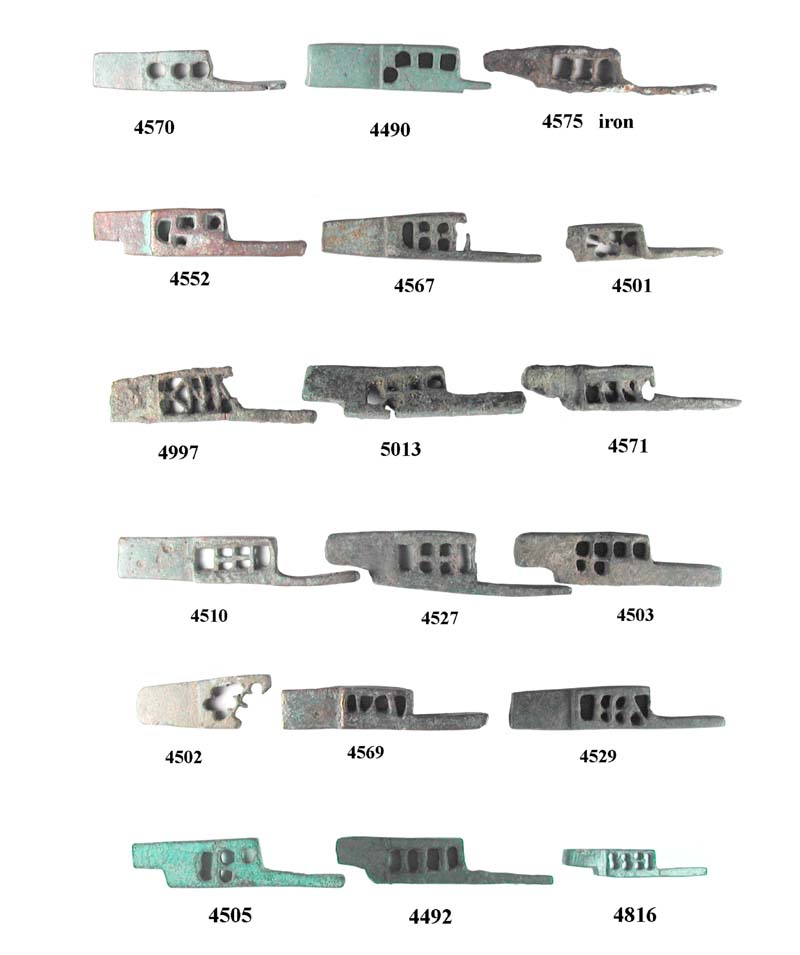
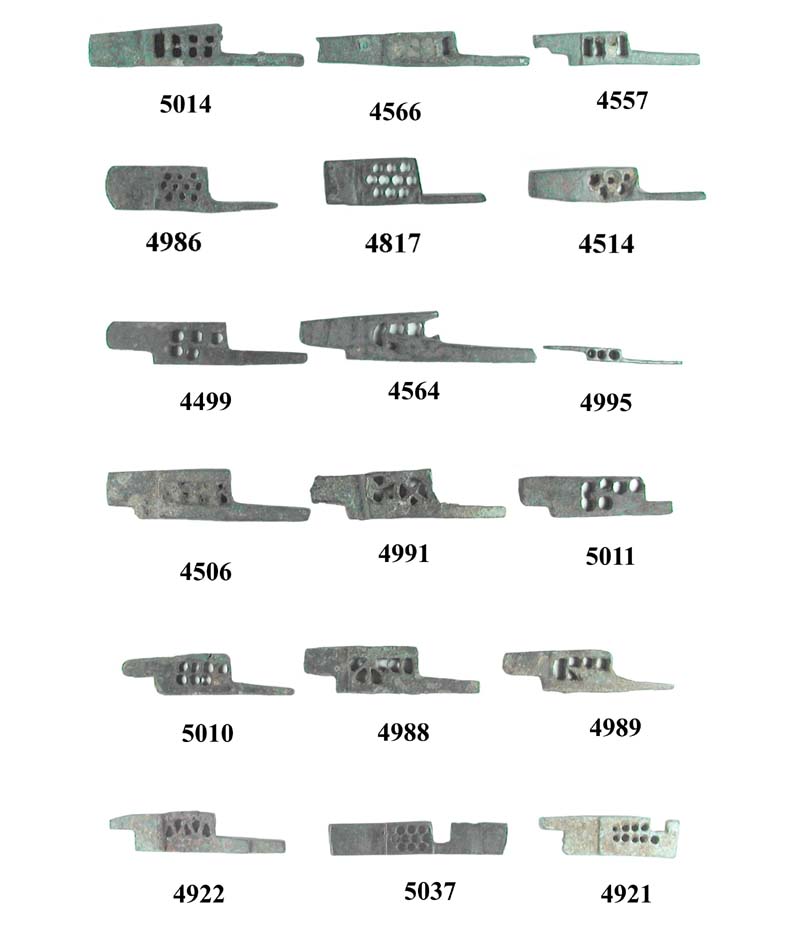
Almost all the holes in bolts are tapered, being slightly enlarged at the bottom. At first I attributed this to preferential corrosion and to wear from contact with the key, but I now believe that holes were made tapered deliberately by the locksmith, to make it a little easier to guide inaccurate key pins into inaccurate holes.
Bolt 4985 type 1a, is a perfect example of taper; there has been no preferential erosion of metal anywhere, yet the holes are wider at the bottom than at the top. Accurate measurements are difficult, but here is a pretty good summary. Dimensions in inches.
Hole number / Width top, inches / Width bottom / Taper
1 0.113" 0.128 0.015
2 0.091 0.120 0.129
3 0.106 0.139 0.033
4 0.125 0.157 0.132
5 0.115 0.150 0.035
6 0.101 0.127 0.026
7 0.084 0.119 0.035
8 0.114 0.133 0.019
The question of taper will be referred to again in connection with double bolt 4993
Bolt 4995 This tiny bolt is unlike any other that I've seen. The head and tail are perpendicular to the pin section. If the pin section is mounted horizontally as in a normal bolt, then both head and tail are vertical. The reason for this design is unknown, but it's probably for a tiny chest with a tiny lock and a tiny hasp. We have a maverick locksmith here, or perhaps one complying with a customer's whimsical requirements!
Bolt 4575. Iron bolts are rare today, probably because of the poor survivability of buried iron. However, they are not unknown, and one example is shown here. The question is, was iron an economic choice? Which was cheaper to manufacture, bronze or iron? And another unknown, were the Romans at all concerned about the rusting of iron artifacts?
Bolt 5061 There are still lots of unknowns about these matters and strange things are turning up all the time. Here's another bizarre piece of hardware: This is an iron bolt designed to accommodate one rectangular pin and one round pin. I suppose it would offer some security if you weren't expecting it, but it's pretty primitive!
Bolt 5108 Type 1a. This is just the heaviest I've found so far, weighing in at 1.8 oz (28 g). However, I've seen much larger ones, and I don't know how sturdy they get.
Single bolts, continued
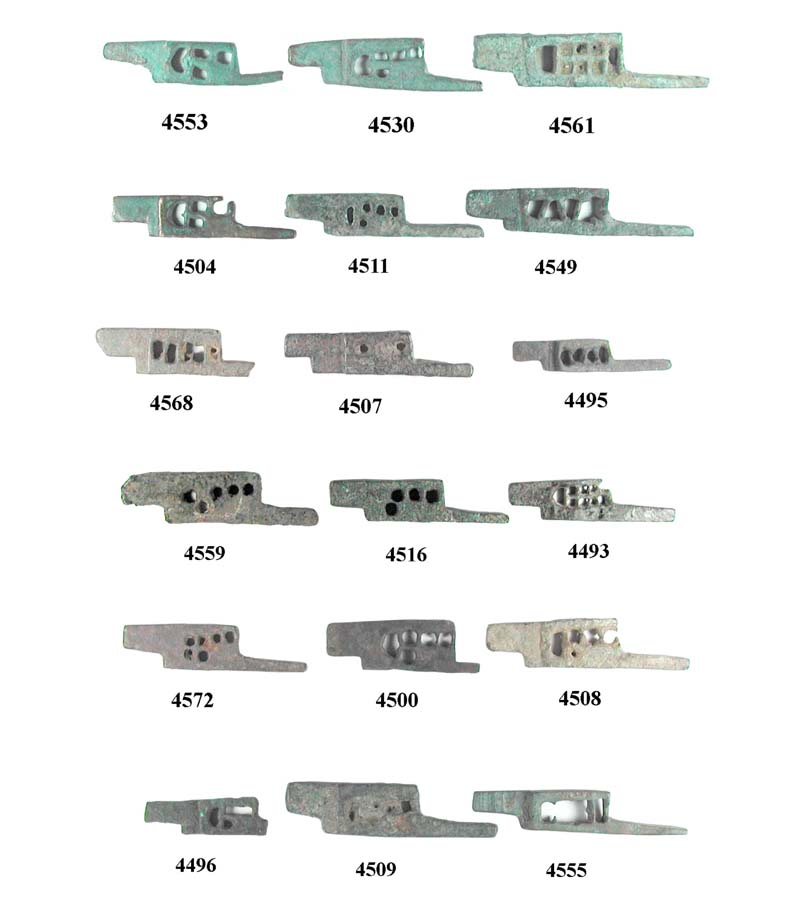

Type 1C, side projection
Vin46 This curious bolt from the finds at Vindolanda has an extension on the side, positioned so that it would be on the inside when the bolt is mounted normally. The purpose for such a device is unknown, and I can only speculate that it might be for operating some other mechanism such as a shutter or open/closed flag..
Detf8 Another example of a bolt with a side "handle", this one from Detector Finds 5.
 Jacobi A bolt is shown in the Jacobi paper
that is both interesting and puzzling. He supposes that it is for a small
casket. Referring to the figure, there is a handle on one end, and it is
explained as a transitional mechanism between wood and metal locks. He shows the
handle extending to the front and the lock is to be opened by pushing up with
the key to free the tumblers (only) and sliding with the handle to move the
bolt.
Jacobi A bolt is shown in the Jacobi paper
that is both interesting and puzzling. He supposes that it is for a small
casket. Referring to the figure, there is a handle on one end, and it is
explained as a transitional mechanism between wood and metal locks. He shows the
handle extending to the front and the lock is to be opened by pushing up with
the key to free the tumblers (only) and sliding with the handle to move the
bolt.
I would like to believe this, but I have a problem with the configuration. If the bolt is mounted in the usual way, with the head notch and the tail away from the lock plate, the center notch to the front, and the eroded surface down, the handle would be on the inside. Since there cannot be a person inside a small casket, it would have to be a lock for a door, and although no scale is given, it seems small for a door. Also, if it were a door lock and did have a handle on the inside, it would violate the conventional wisdom that the Romans never invented a metal lock that could be operated from both sides. This remains a very small unsolved mystery.
Type 1D, pinning holes in head
Bolt 4904,4904b. An unusual design with a split end featuring two vertical circular pieces. These extensions accommodated an iron pin, the remnants of which are still in place. I assume that this was for pinning the bolt when it was closed so that no key or pick could open it. I suggest that this was a trick lock, with the head of the pin concealed in the lock plate. This could have been done by hiding it under a knob, for example. The last time this bolt was used, something didn't fit quite right, causing the bolt to become bent and cracked. Takes a lot of applied force to do that!
Type 1E, center notch
Bolt 4921 This one has no tail. Instead, the locksmith has cast or cut a notch in the side of the bolt, purpose unknown to me. Oddly, the pin holes are far to the rear of the bolt, extending all the way to the center of the notch. Therefore the notch could possibly have served as a key guide or even a pin hole for a very unusual key. Note that in all the examples in this collection that have notches: 4921, 5037, 5016 and 5041, (and in another that I've seen), the notch is always at the front of the bolt.
Bolt 5037. Much like 4921 in having a notch and no tail. Note the section immediately following the notch. It is beveled to a sharp edge, for some purpose not known to me.
Type 1f, slot in head
Bolt 5019a,b This curious item has a full width head, but with an L-shape slot in the front. The purpose is unknown, but perhaps to accommodate a vertical guide pin?
Type 2, double bolts
Double bolts for top-opening containers are most interesting of all, in that they offer several more features that are not yet understood (by me). For chests using double hasps, the tail of the bolt is extended and recurved to catch the right-hand hasp. The configuration is the same for all double bolts in this collection; the working head extends only about 40% across the width of the bolt.
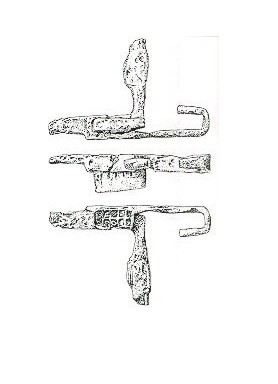 All the heads on double bolts that I have seen are either
narrowed or split. I believe that the purpose of a split head on a bolt is
simply to modify a stock design to fit into the loop on the hasp of a top
opening casket rather than into the keeper on a side opening chest.
All the heads on double bolts that I have seen are either
narrowed or split. I believe that the purpose of a split head on a bolt is
simply to modify a stock design to fit into the loop on the hasp of a top
opening casket rather than into the keeper on a side opening chest.
The image at left shows a double bolt with key in place (Osnabrueck). Views from the top are: bottom, front side, top.
There is another interesting feature that I've observed about double bolts. Most of the examples, including some not in this collection, are curved, and always in the same direction. At first I thought that they got bent when the barbarians smashed the lock! Or after the owner lost the key and ditto. After seeing so many, though, I think they were made that way deliberately for containers with curved surfaces. However, if they did really conform closely to surfaces, the containers would be unreasonably large, probably much larger than capsae. Also, I haven't seen any curved cover plates.
There is also the question of the high ridges that appear on some bolts. From my limited experience, it seems that they are much more common on double bolts than on single ones. I can only speculate that they are wards, requiring a key with an unusual shape.
Single bolts, continued
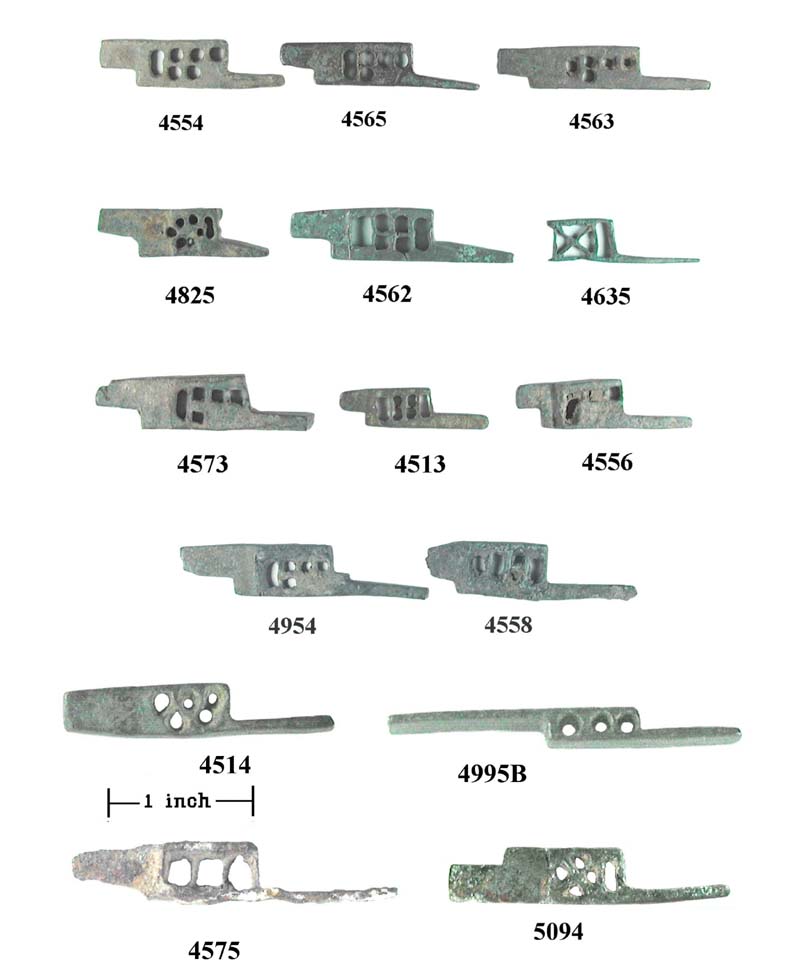
Type 2A, Narrow head
Bolt 4824. The pin holes are plugged with corroded iron, enough metal remaining to show magnetic attraction. There are several tiny black bubbles on the residual iron corrosion on both top and bottom surfaces above and below the pin holes.
Bolt 4926 The smallest bolt in the collection. This seems a little silly, since it would fit hasps only 1.5" apart. Perhaps for a child's box of goodies?
Bolt 4799H. This is part of chest lock group 4799, which is a nice illustration of how the double hasp latching system worked.
Bolt 5040 That irregularity at the right end is where the bolt was broken off the sprue after casting, and not cleaned up by a sloppy artisan. That tells me what the wax assembly looked like at the foundry. I hadn't seen this before because all respectable shops cleaned up such irregularities. A suggested casting assembly is shown in 5040e.
Bolt 5046 An unusually thick and heavy bolt, mostly 0.4" thick. In the center is a beveled section about 0.7" wide. This bolt is very much stronger than necessary, and is surely for a cupboard or very substantial chest.
Type 2B Split head
Bolt 5016 This is the one of the most complex and interesting bolts I've seen. It has several features suggesting that there was originally much more mechanism. The bolt head is split, I assume because it is designed to fit into a hasp rather than a keeper. A beveled tab has been added in the center of the bolt, which has two sections, with two different bevel angles. In one section there are the rust products of an iron pin, in which there is remains still enough metallic iron to be magnetic. It could perhaps be a double locking device in which a pin is dropped in from some outside control.
Bolt 5015 Split head again. Very prominent guides and stops. Rear guide has a pronounced bevel.
Type 2C Split head with center tab
Bolt 5041 Another interesting one, with the extreme split bolt end and beveled tab in the middle and deep ridges. I have rejoined a recently broken off section at the tail as shown in image 5041c. Image 5041a shows the two sides of that break, and that intergranular corrosion had penetrated entirely through the bronze, making it very brittle and fragile. There was another break at the end, this one made in antiquity. Image 5041b shows what I believe the bolt looked like originally.
Single bolts, types 1c - 1e
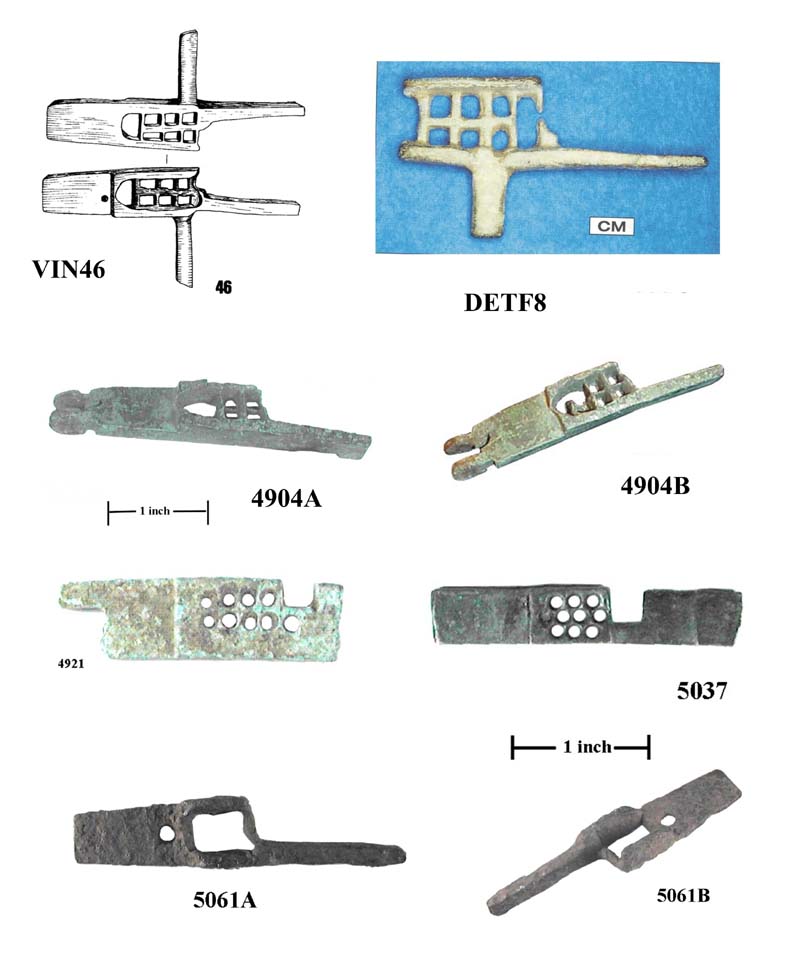

Double and triple bolts
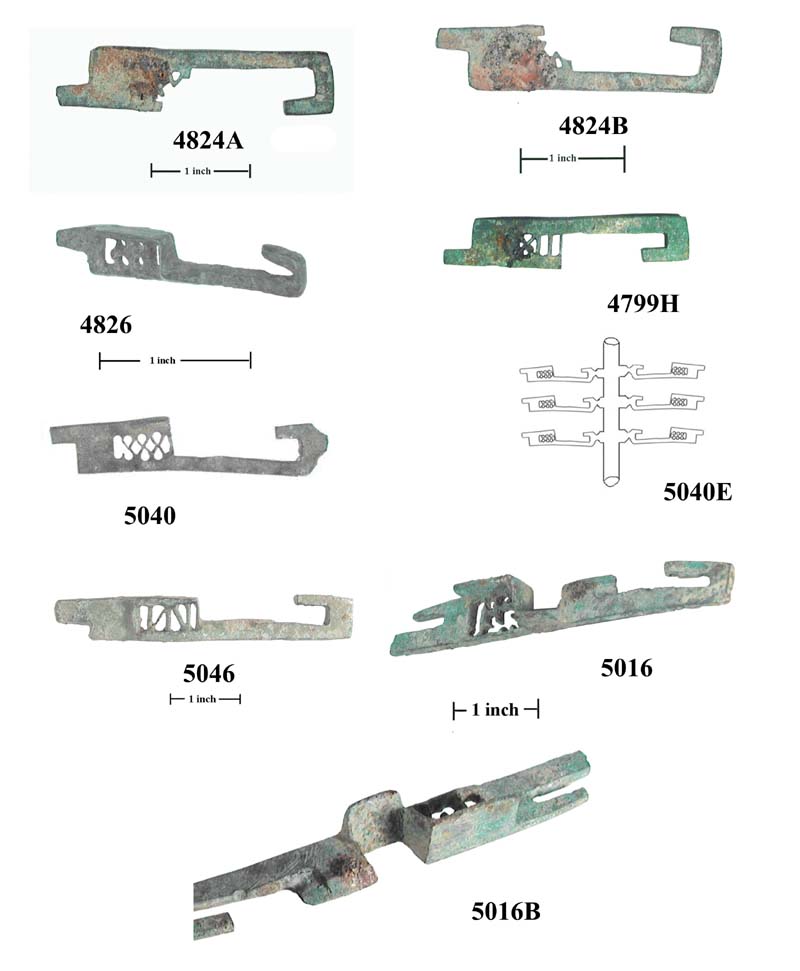

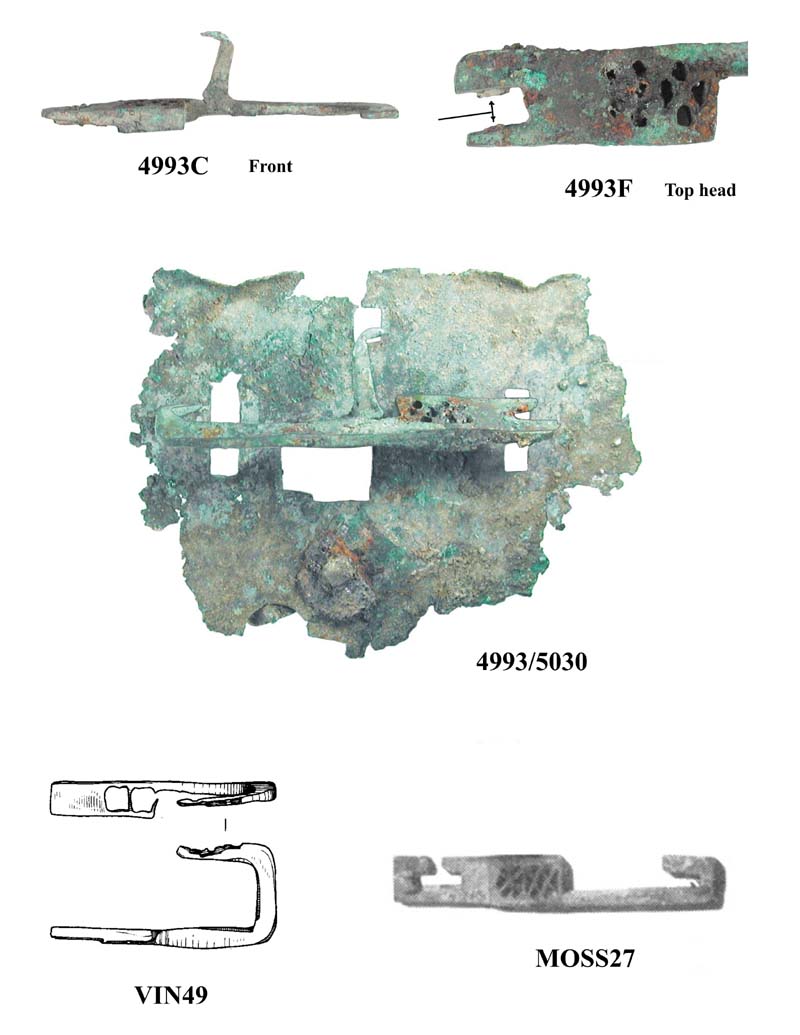
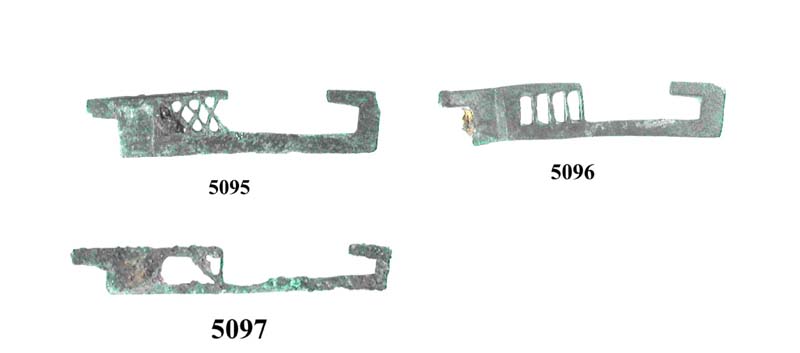
Type 2D Double recurved
Moss27 From Mossman, p.27 This is evidently a double bolt, but both ends have recurves to pin and release hasps.
Type 3 Triple bolt, split head with top arm, ("scorpion")
Bolt 4993. A "scorpion bolt". This is an extraordinary and valuable bolt, not for its quality, which is poor, but for the questions it suggests about the construction and use of chest locks. From examination, it appears to have begun as a wax model for fairly ordinary cast bronze bolt. Then it was modified for some special installation, and the corrosion residues show that all the changes were done in antiquity. Tool marks and irregularities show that these modifications were performed by a very unskilled workman.
A long piece of wax was crudely cut and fused to the original "tail" to make it into a bolt for a double hasp. A second piece was fused to this assembly, pointing upward when the bolt is in the normal operating position. The top of this spike points forward and the whole arm was aligned so that it was in the correct position to operate a third hasp. It's not proved that that was its actual function, but I made the following observation: if bolt 4993 is matched up with the reverse of plate 5030, it is a near fit (4993/5030), and we have also found a purpose for that top slot! I don't wish to imply that these two pieces were from the same lock. This also explains why there is that crack at the base of the arm: someone tried to throw the bolt when that top hasp was slightly misaligned and head #3 struck the hasp rather than the loop.
All the holes but one in the bolt are more or less plugged by the residues of iron pins, and the top of the bolt shows that it was in contact with an iron plate. The holes are tapered as usual, but this was not done by wear, as evidenced by the prominent ridge around one hole. This shows that the "wear" always found on the underside of a bolt is actually where the hole was relieved for easier entry of the key. These are, after all, low tech mechanisms and required loose tolerances to operate at all!
A deep notch was cut in the forward end of the bolt, again very crudely. On the underside, the remains of an iron plate are now attached to the bronze with corrosion; some metallic iron remains. An outline can be seen on both top and bottom where there was contact with iron plates. There are two tiny bubbles that appear on the iron, similar to welding spatter. This is the only example I've seen of "weeping" corrosion. An iron residue can also be seen inside one arm of the cut. The conclusion must be that the bolt when closed was seated in an iron keeper, which was attached to a wood frame. The fact that no such fittings have been reported previously may be due to their fabrication from perishable iron, but more likely because normally bolts just seated in wood. Very few bolts show iron residues on the end, which may also be due in part to their last moments of service. The vast majority of chests must have been abandoned, lost or destroyed with their locks in the open position. The owners just cleaned out their chests ahead of the barbarians at the gates and didn't bother to relock them. Why should they, since they were empty?
Vin49. Another example of such a "scorpion bolt" with a vertical recurved extension is in the Vindolanda report, # 49, shown here. This top projection is bent over slightly so that the end lines up with the center of the bolt head.
Not every chest or box lock would have required a metal hasp, and the number of hasps available today is much smaller than the number of bolts or keys. Each has at least one loop at the lower back for the bolt and most are rectangular. However, several in this collection are circular. I've never seen a bolt with a circular head, and I think that in order to ensure a fit, this shape would require a bolt with a pointed end. These are to be found only in double hasp bolts.
All hasps that I am aware of were made of cast bronze. The main style of fastening at the top is a simple horizontal hole which could revolve on a circular fitting. All figural hasps except for 5019 are of this type. The other style is a hinge, with a pin through it to accommodate a mounting fixed to the chest. These are more common in non-figural hasps.
Type 1 Figural Hasps
The most desirable and expensive hasps were and are those cast with the figures of persons. The herm was adapted to this usage. A herm is a rectangular stone or bronze pillar supporting the bust of Hermes, with male genitalia toward the base of the pillar. They were used as boundary markers by the Greeks, and later were adopted by the Romans as a traditional art form. Themes for the miniature bronze herms made for casket hasps were extended to include various gods, soldiers, animals and important persons, mostly unidentifiable at this time. It has been suggested that lars, or household gods were sometimes represented, but I don't suppose it's possible to confirm that. I expect that the models for figural hasps have complex histories. Some features are blurred by corrosion. I suppose these were top-of-the-line products, but even here the quality is variable, ranging from crude effigies to minor works of art. Curiously, no figural hasps were found at provincial Augusta Raurica.
Hasp 4916 Unidentified
Hasp 4929 Unidentified
Hasp 4994 Venus/Aphrodite washing sea foam from her hair.
Hasp 5017 Woman with right hand to chest, left over groin
Hasp 5019 The dolphin motif, a Roman favorite.
Hasp 5022 Woman with folded arms
Hasp 5038 Unidentified
Hasp 5045 Unidentified
Hasp 5118 Alleged to be Mercury
Type 2 Double Hasps
Usually a single hasp was all that was required, but a few were made for two bolts on the same (left) side.
Hasp 4977 Unidentified
Hasp 5032 Hercules, in a conventional pose with lion skin and club.
Hasps 4977b and 5032b Reverse, showing loops
Hasp 5050 Another version of Venus; excellent modeling, but unfortunately the bottom loop was broken off in antiquity
Hasp 5069 Third example of a Venus hasp. Compare to 4994 and 5050 above. Evidently all three were copied from a single piece of statuary. Oddly, all 3 Venus have front-to-back mounting holes, while the rest have side-to-side holes. It seems we're missing some little design conventions here and there. Roman trivia, you might say, but perhaps it has something to do with the purpose of the boxes they were used on.
Hasp 5113 Very nicely detailed, perfect condition and with excellent patina, perhaps a figure of Hermes.
Figural hasps
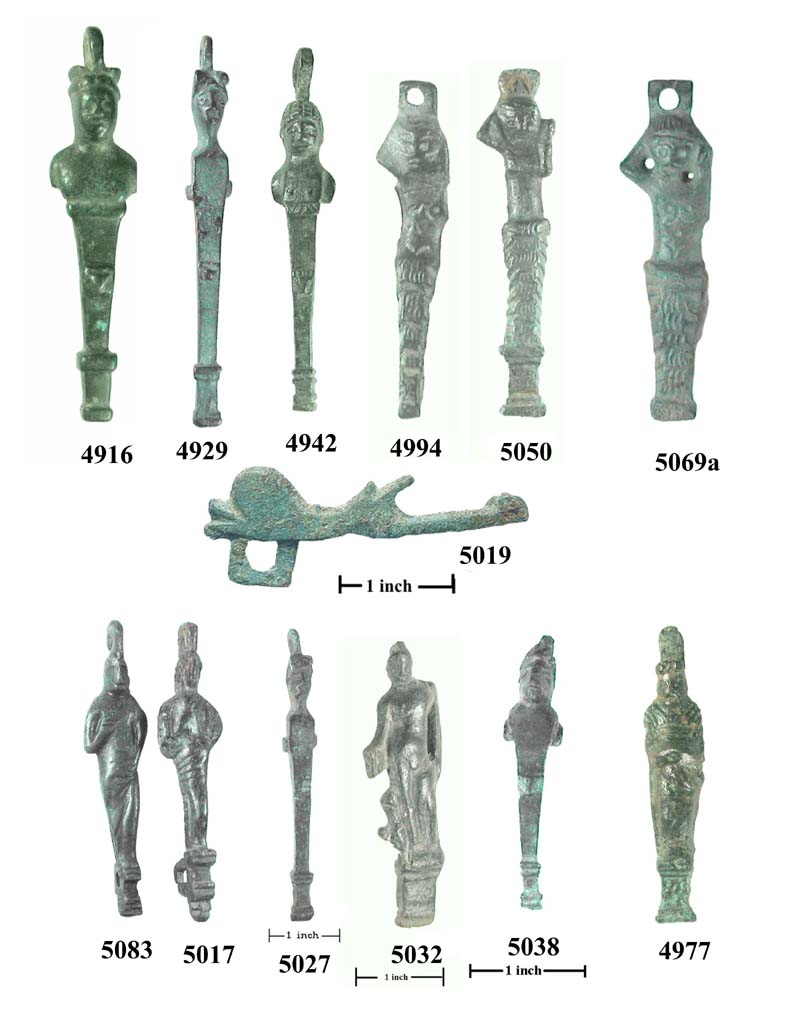
.jpg)
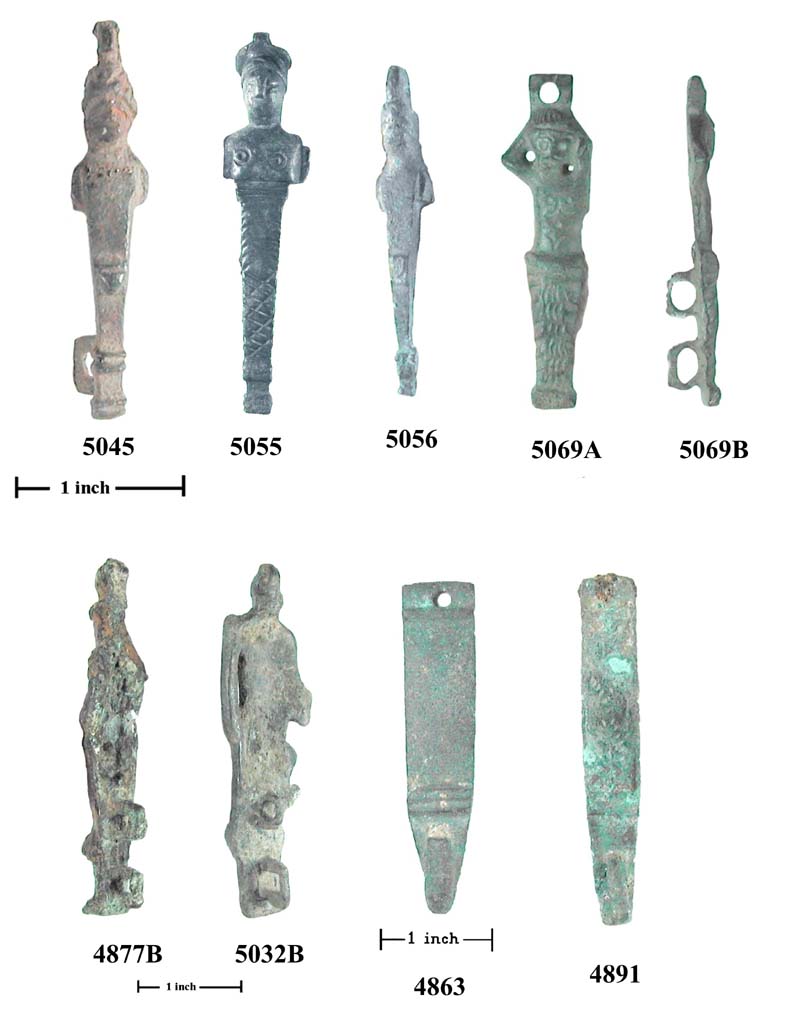
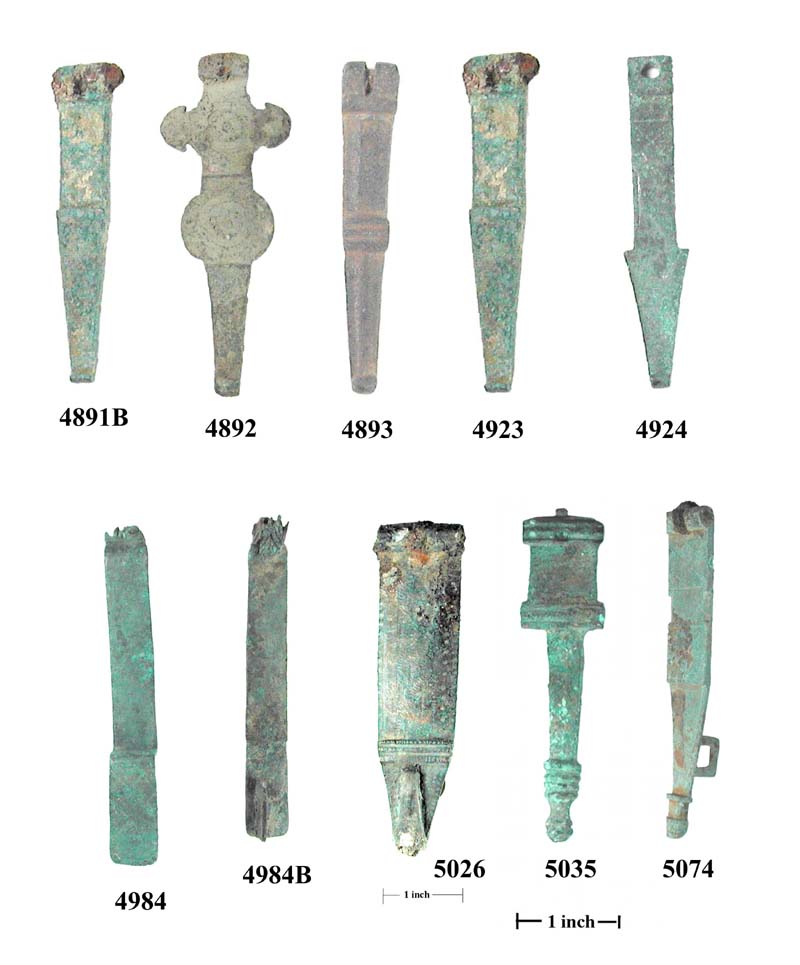
Type 3 Offset Hasps
Occasionally we find hasps that have an offset in them, such as 4984. This requires the locks to have been mounted on a wood or metal extension protruding from the surface, rather than on the surface itself. I suggest that one reason for this practice might have been that it allowed lock makers to prefabricate some of their wares, and build up a stock to allow fast service for a customer. A prefab lock could then just be nailed or pinned to the chest. 4894b is the back side of 4894, showing what appears to be the remnants of a wire cable.
Type 4 Geometric Hasps
The "standard" design seems to have been a strip of metal, decorated with various combinations of bands, cuts or other embossed or engraved geometric designs, such as the circle/dot.. I assume that 4892 is a Christian motif. A similar hasp is shown in Malloy, #1706
As with other fittings, chest handles were often elaborately decorated, depending on the taste and wealth of the owner.
Triton. Shown here is a Triton, a figural handle from Augusta Raurica (from Emile Riha).
Handle 4896 The others from my own collection include 4896 in a similar style
Handle 4962 Folding, fastened to its decorative rosette with a Roman cotter pin, and shows significant wear from usage.
Handle 4979 Figural, the only herm I've seen used as a handle. Unidentified male.
Handle 5087 Iron, but not unattractive, with twisted body and carefully made loops at the ends.
Handle 5100 So nicely done it looks like it was turned on a lathe, but of course wasn't.
The Romans had a deity for just about everything. Carna was the goddess of door hinges, among other things, and protectress of the exteriors of houses. Many hinges were found at Augusta Raurica. Chest hinges do not often appear on the market. One reason for this is that some hinges were made of leather, which survives burial only in special environments. Other hinges are very plain, and may have been unrecognized and discarded by finders. That of course does not apply to archaeologists, who save every tiny bit (forever).
Hinge 5009 Shown here is a very sturdy and attractive hinge in bronze. Note that the hinge does not correspond to the edge of the surface on which it is mounted.
Hinge 5024 Interesting hinge with a very modern appearance, but notice the traditional Roman winged disk motif
Hinge 5070 Delicate twining vine design
Hinge 5085 This is an odd one. The front plate is shaped at the top to retain the hinge pin, then continued down the back to form a narrow strap. The cross and slot cutouts on the front may be just decorative, but the slots could also have been used to retain a strap. Also the side slots look a bit like strap or ribbon retainers. However, whatever embellishments it may have had, this is definitely a hinge, and there are remnants of the iron pin at the top. The separation of front and back show that it was mounted on a thin plate, probably of metal. The hole in the back strap is broken out, but back and front were joined by a fastener through the front center hole.
Hinge 5090 Offered as a chest lock plate, but the pin mount at the top makes it either a hinge or a hasp. If it were a hasp, the vertical slot would require it to fit over an exposed staple for a padlock in the modern manner, so for now I'm guessing it's just an odd hinge.
Handles
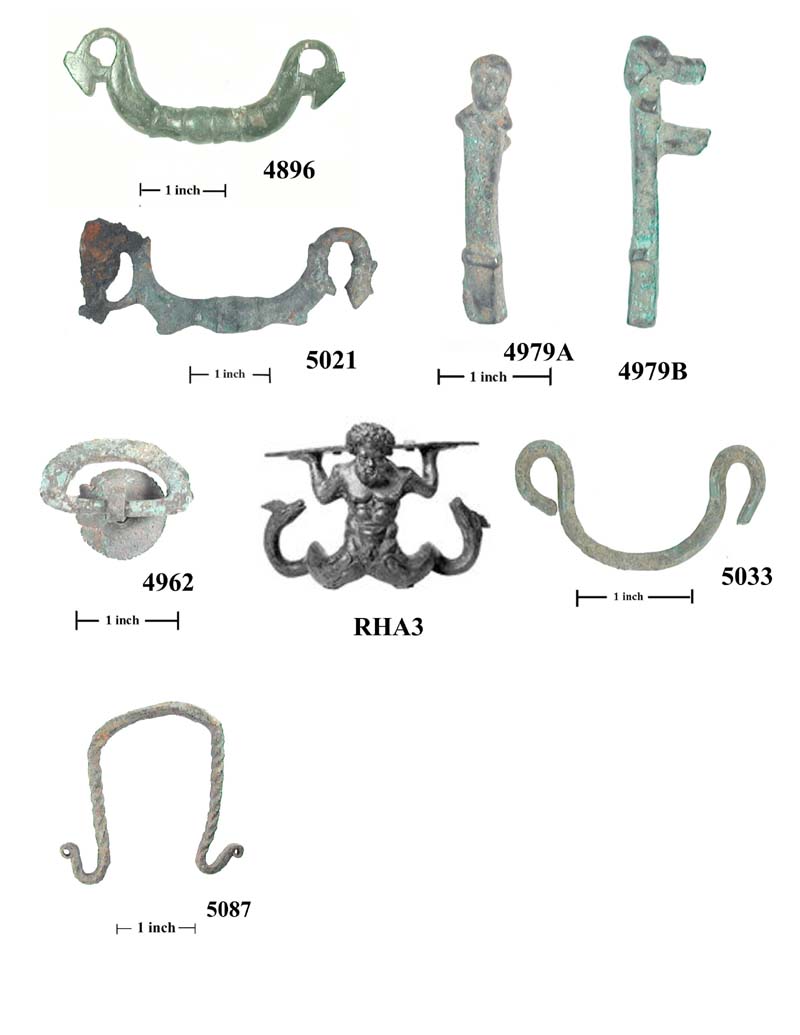
Hinges
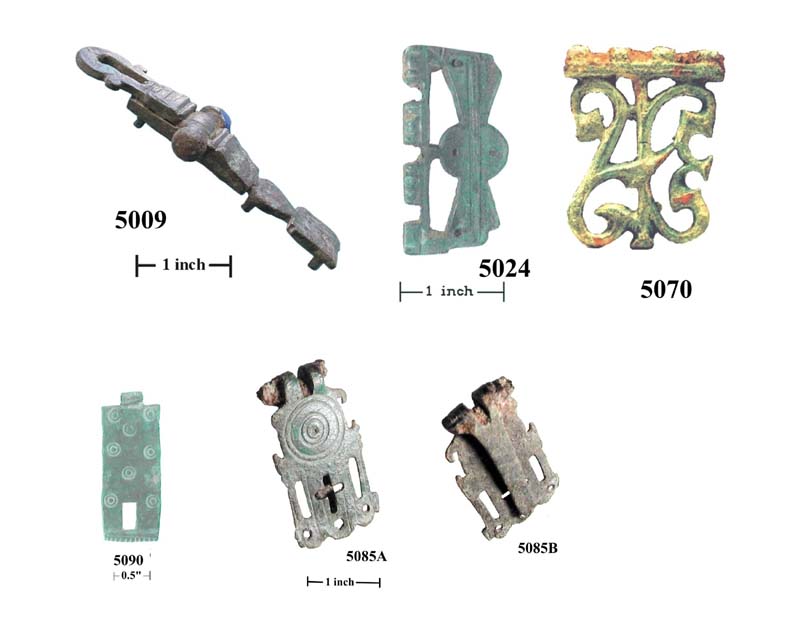
Very often, the fluted rings that accompany plate groups are offered as handles, but these are probably decorations, especially as so many are found in some plate groups. The use of movable fluted rings as decorations is a peculiarly Roman usage. They were attached to chests with clips 5016b, which are instantly recognizable to us as cotter pins! Other types of decorative attachments are known, but seem to have often become separated from the other hardware. The usual way of identifying them is by remaining pins or by attachment pin holes, as in 5062.
The plate composed of a circle with two side "wings" is a favorite decoration, and I assume that it represents a sun with rays (Apollo?) Note its use again in hinge 5024.
Plate 5072 appears to be a decoration for a box about three inches wide. It has a simple decoration of scribed lines, and shows traces of silver plating. It is serrated on one edge only, for no obvious reason. The heads of two pins remain.
Chest Decorations

Combination locks were known to, and undoubtedly invented by the Romans. I have found only three references to them. The first is a brief mention of their existence by Stockmyer (kcmetro). The second is on a web page from the University of Osnabrueck (Osnabrueck) where is shown a photo of two knobs from a Roman combination lock, with little further explanation.
The third reference (Hoepfner, 1970) describes what seems to be the most complete example known, and in view of its unique status and great interest, I have included it in these notes. It is ascribed to Roman imperial times, and appears to be largely unknown to lock historians and collectors. It was found in a grave in the Kerameikos, the ancient graveyard of Athens, and has been analyzed in detail.
The text of the article is in German, and it appeared in a journal not readily accessible to U.S. collectors. However, I have translated it into English in order to understand how the lock worked, and the description was taken from this (imperfect) translation. Shown here are a drawing of the front surface of the lock and a reconstruction showing how it might have been mounted on a box.
The lock is of bronze and is composed of three rotating knobs mounted on a lock plate, controlling the movement of a bolt into a conventional hasp. To open, the three knobs must be aligned in the proper directions. Its mechanism is extremely simple, and would provide minimal security to anyone familiar with the concept of combination locks, but may have been baffling at the time. It may even have been just a high-tech toy for a wealthy patron. As an invention, it is an amazing piece of work.
Combination Locks
